Causes and ways to overcome the voltage surge of grid-tied inverters when the inverter reports a high-voltage fault
- 08-01-2022 10:49:01
- 115
Why does the grid-tied inverter stop working when reporting an AC overvoltage fault?
Regulation on electrical equipment, part I: General provisions, article I.2.39:
“I.2.39. The voltage level at points in the power grid must be determined according to the mode of operation and the mode of maximum and minimum load. Under normal conditions, the voltage deviation is allowed to fluctuate in the range of +- 5% compared with the rated voltage and is determined at the location where the electrical measuring equipment is placed or at another location agreed upon by the two parties. . In case the grid is not stable, the voltage is ranged from -10% to +5%."
This means that the voltage of the grid will fluctuate in the range of 207 - 241.5 V
According to some inverter standards, manufacturers will specify the AC voltage threshold. Inverter will trip when:
- AC voltage exceeds the allowable voltage threshold for a certain period of time.
- When the voltage is lower than the specified threshold.
When inverter trip in case of “Overvoltage" error. At that time, the grid voltage was outside the rated operating voltage range of the inverter.
Power attenuation mode according to inverter's voltage
In some cases, when the voltage reaches the threshold at the edge, the inverter will reduce the output power in response when the grid voltage is higher than normal.
When the output power of the inverter decreases to meet the rising grid voltage. This phenomenon is known as "Volt-watt feedback mode".
Let's find out together through the image below. Inverter will reduce capacity at a certain voltage level.
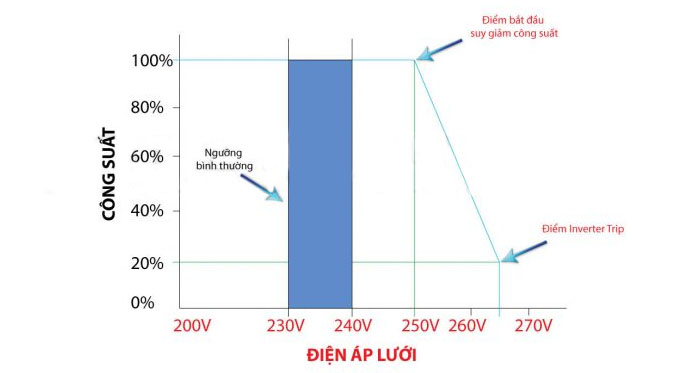
This is a protection function of the inverter. Therefore, we will need to pay attention to the voltage quality of the grid when installing a solar power system.
Why does the inverter trip or reduce the output power when the grid voltage is too high?
We will have the following basic reasons:
- The mains voltage is beyond the standard operating voltage range of the inverter.
- The grid voltage is near the threshold. When operating the inverter has pushed the voltage beyond this limit.
Let's take a closer look at the second reason:
Pressure boosting in solar power system
When the solar power system generates more electricity than the load needs. The excess power will be filled back to the grid.
In order for electricity to flow from the solar system to the grid, the inverter voltage will need to be several volts higher than the grid voltage. Under ideal circumstances, that's a negligible gain.
For example, the inverter will increase the voltage from 230 to 232 V.
The problem will occur when the wire connecting the inverter to the grid is too small compared to the capacity of the solar power system. Why did this happen?
VOLTAGE = CURRENT X RESISTANCE
Voltage is the force to help current move. In Vietnam, the current voltage of the grid at standard level is 230V for single phase system.
Current is the magnitude of the flow of electrons in a conductor.
For example, a 5kW inverter will pump about 20A into the grid at noon.
Resistance prevents current from flowing in a conductor. Resistance depends on conductor cross-section, length and fabricated material. We usually measure resistance in Ohm units.
OHM .'s Law
Ohm's law expresses the relationship between voltage, current and resistance:
V = I x R
Voltage = Current x Resistance
To create a balance, if the resistance of the wire is large, the inverter voltage will need to increase or the current will need to decrease.
However, no one reduced the current. And the only way to balance both sides of that formula is to increase the voltage higher.
The higher the resistance of the conductor, the higher the voltage will have to increase to push the current into the grid.
Why do we need to care about boosting in solar power system???
1.Inverter overvoltage fault cycle
As mentioned above. To push the current to the national grid, the inverter itself needs to increase the voltage higher than the grid. So when is the time when the current pushed to the grid is the largest? that is at noon
At noon the voltage will reach the highest level to be able to push the current to the grid. And when there are many neighboring solar power systems to bring electricity to the grid. Everyone is raising the grid voltage at the same time. At this point the inverter will need to bring the voltage up even higher and…
.....Inverter stopped working.
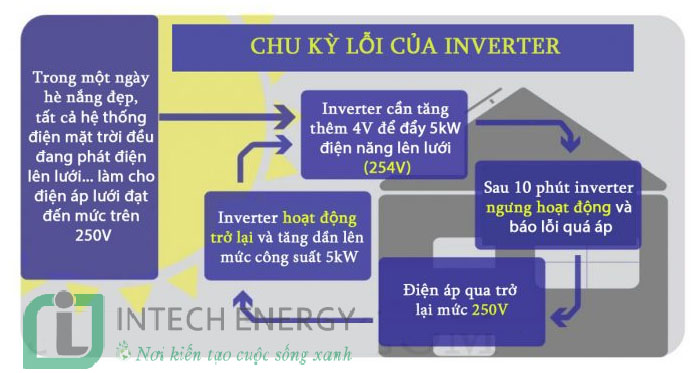
2. Damage to electrical equipment
If the inverter keeps tripping and restarting, it will affect the inverter itself. In addition, there are devices such as motors, fluorescent lamps due to the high voltage of the grid.
Steps to check and fix
Check the voltage of the grid
We need to shutdown the solar power system before checking the voltage of the grid. Besides, turn off all the loads with large capacity in use.
It is advisable to carry out the measurement process at noon. This is the period when the neighboring installed solar power systems will affect the grid voltage the most.
Step 1 – Record the instantaneous voltage value on the meter. If the value exceeds the specified voltage threshold, we will take a picture and send it to the power side.
Step 2 – Return the voltage value for about 10 minutes using a counter with built-in logger. Note that we need to turn off the solar power system as well as all large capacity loads. If the average value exceeds the allowable voltage threshold, we should send information to the power side.
Check voltage drop in installed solar power system.
Let's ask the solar power system design consulting company to check the voltage drop of the system on the AC line. At the same time, upgrade the line to the grid if the voltage surge causes the total voltage to exceed the allowable operating threshold of the inverter.
Step 3 – Check the voltage rise. If the mains voltage and voltage drop of the conductor are standard, let's measure the voltage gain as follows:
- When the solar power system is not in operation, turn off all loads and measure the no-load voltage at the main power supply cabinet.
- Supply power to a resistive load (oven/microwave... ) and measure the amperage in the hot wire, the neutral wire and the voltage at the main power supply cabinet.
- From there, we calculate the amount of pressure boost at the point of power supply to the load
- Or use the tool WireWizard (supports iphone) or on the website platform
- Calculate the total resistance of the AC conductor and connection points.
Case #2 – The grid voltage is stable, the voltage drop of the AC grid line is less than 4%, but the system still tripped. Now we have the following options:
- We can change the Trip value after a fixed period of time to a higher level (depending on the support capacity of each inverter model – “VOLT RESPONSE MODES" )
- Otherwise we will need to upgrade the AC conductor or limit the amount of power generated by the solar power system to the grid.
News other
-

How many types of solar inverters are there?
10-01-2022 17:15:06 Details
-
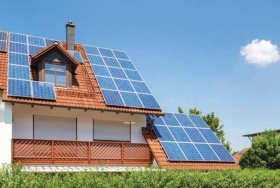
Install a solar battery system properly
10-01-2022 16:25:02 Details
-

The Vietnam Renewable Energy Community organizes a Caravan journey towards the Central region
10-01-2022 09:12:28 Details
-

Solar panel system rotates in the direction of the sun – Up to 30% higher efficiency
10-01-2022 09:11:15 Details
-
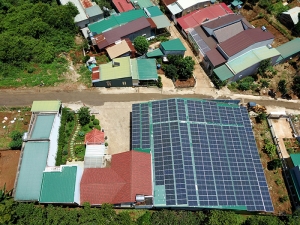
Why is solar power in the Central Highlands extremely ”hot” in 2020?
10-01-2022 09:04:02 Details
-
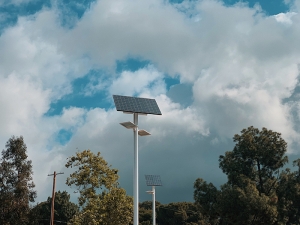
What are solar lights?
10-01-2022 09:01:07 Details


